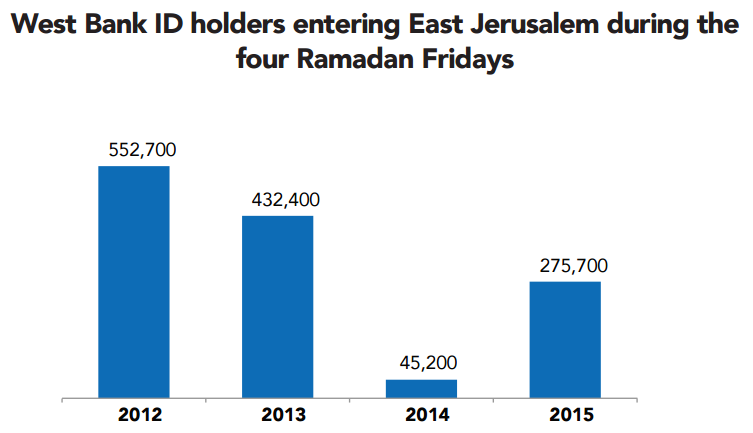Movement restrictions temporary eased during Ramadan
Some restrictions reinstated following Palestinian attacks
For the month of Ramadan, which started on 18 June, the Israeli authorities relaxed some restrictions on the movement of Palestinians within the oPt, including East Jerusalem, and between the oPt and Israel. These measures had a positive impact on the right of Palestinians to freedom of movement, to freedom of worship and to family life. However, in response to a series of Palestinian attacks (see Decline in Casualties section), the Israeli authorities progressively revoked some of these measures, raising concerns about collective penalties.
Until recently, all Palestinians holding West Bank IDs were prohibited from accessing East Jerusalem without obtaining a special permit. Permit holders may access the city via four checkpoints along the Barrier: Qalandiya, Gilo, Shufat, and Zaitun CPs. On March 2015, the Israeli authorities lifted the permit requirement for men over 55 and women over 50 crossing one of these checkpoints after 8 am.
During Ramadan, exemption from the permit requirement was extended on Fridays to men over 40, boys below 13 years and all females, to allow more people to attend Al Aqsa Mosque for the traditional prayers. Males between 13 and 40 years of age were eligible for permits. Similar permits were issued to a few hundred Palestinians from the Gaza Strip. Individuals crossing the checkpoints underwent two to three inspections and searches by Israeli forces.
Prior to Ramadan, the Israeli authorities had reportedly proposed to the Palestinian Authority (PA) that people board buses in Palestinian cities and travel directly to Al Aqsa Mosque with their IDs and permits checked by PA personnel prior to boarding. The proposal was ultimately not implemented due to the refusal of the PA to carry out the security checks requested by the Israeli authorities.

During this period, the Israeli authorities also eased the criteria for issuing permits to West Bank ID holders for access to East Jerusalem and Israel for the purpose of family visits; this included the lifting of the “magnetic card” requirement. Several hundred additional permits allowing Palestinians to travel via Ben Gurion airport in Israel were also issued.
Following attacks by Palestinians on the third and fourth Fridays of Ramadan, the Israeli authorities narrowed the age criteria to access East Jerusalem without a permit (men over 50 and women over 30). They also revoked all permits issued to residents of Gaza and of Sa’ir town (population 22,400) in Hebron, home to the perpetrator of one of the attacks, and to travelers via Israel’s airport. Despite this, about 800 permits were issued to residents of Gaza to attend the Laylat al Qadr (Night of Destiny) celebrations in East Jerusalem on 13 July. Lack of clarity regarding these changes and insufficient dissemination of relevant information resulted in confusion, friction with Israeli forces, and hundreds of people being turned back at checkpoints during the last two Fridays of Ramadan.
More than 275,000 crossings took place via the four authorized checkpoints. The highest figure of 120,000 was recorded on the second Friday, while the volume on the other three days fluctuated between 50,000 and 56,000. While this represents a large increase compared to Ramadan 2014, the figures are lower than in 2012 and 2013. Ramadan 2014 featured a peak in tension due to the Gaza hostilities and military operations and clashes in the West Bank, alongside severe access restrictions into East Jerusalem.
Also in Ramadan, the Israeli authorities opened a road connecting Hebron city to the nearby town of Bani Naim (population 25,700), which has been closed since 2000 following the beginning of the second Intifada. This opening has almost halved the distance between the two localities (from 20 to 11 kilometers), thereby facilitating access to services and workplaces, and reducing transportation and logistics costs to dozens of quarries and stone factories operating in the area.









